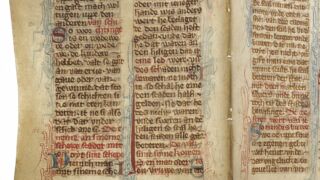A 2.8. Splitting
A 2 damage subcategories:
A 2.1. Holes
A 2.2. Hair remains
A 2.3. Striations
A 2.4. Traces of jagged action
A 2.5. Veining, vein evidence, drainage of blood vessels
A 2.6. Variation in thickness
A 2.7. Opacity, transparency
A 2.8. Splitting
A 2.9. Variation in colour or surface appearance, matte, semi-matte, glossy
A 2.10. Presence of grain layer
Grain layer completely removed throughout the entire surface.
Parchment could be made using either one-sided skin splitting combined with machining on the other side or two-sided splitting. Soaked sheepskin and goatskin could be split particularly well. When properly split, the surface thickness of parchment was usually more uniform. As a result of sloppy splitting, the grain layer on the verso side can be partially retained, and this accelerates the degradation of the parchment.

Ürik TLA.230.1-i.811, 1484. a.
Lõhestatud nahk.
Kahepoolselt lõhestatud, õhuke pärgament, millel puuduvad pärgamendi mehaanilise töötlemise jäljed.
Läbivas valguses on hästi nähtavad pärgamenti läbivad karvanääpsuaugud.

Ürik TLA.230.1.cm10, 1433. a.
Lõhestatud nahk.
Kahepoolselt lõhestatud, õhuke pärgament ilma töötlemise jälgedeta. Läbivas valguses on hästi nähtav lõhestamisel saavutatud pärgamendi ühtlane paksus üle kogu pinna.
